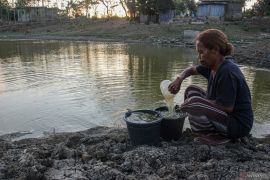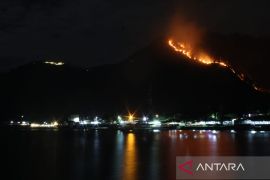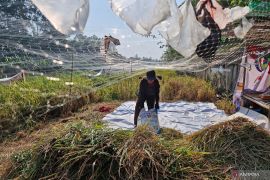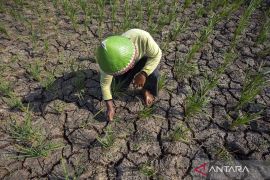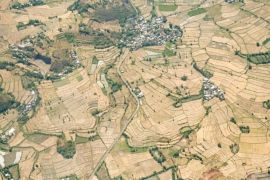Of the 8.61 million hectares of rice fields in Indonesia, about 3.3 million hectares of rain-fed rice fields are prone to drought.Jakarta (ANTARA News) - The ongoing drought affecting various parts of Indonesia will not cause shortage of rice this year as the government has taken anticipatory steps to reduce its impacts on rice fields.
Indonesia has set its rice production target for 2015 at 46.14 million tons while its annual rice requirement is only about 28.5 million tons.
The Ministry of Agriculture has forecast that it will reduce the impact of drought on rice farms from 200 thousand hectares in 2014 to 100 thousand hectares this year.
Hence, based on the five-ton rice production in every hectare of land, the drought this year will reduce rice production by only five thousand tons of the targeted 46.14 million tons.
Of the 8.61 million hectares of rice fields in Indonesia, about 3.3 million hectares of rain-fed rice fields are prone to drought.
However, Agriculture Minister Andi Amran Sulaiman has made assurance that the current drought will not affect the rice production, which will remain adequate. The government has even managed to successfully save Rp2 trillion worth of rice this year until July this year.
Some 198 thousand hectares of land across Indonesia is hit by drought every year.
"Last year, the drought affected 200 thousand hectares of rice fields. It is forecast that it will affect only 100 thousand hectares this year. This means that we will save 100 thousand hectares," Minister Sulaiman noted in Mataram, West Nusa Tenggara (NTB), on Friday, July 31.
He affirmed that during the period between October 2013 and July 2014, 159 thousand hectares of rice fields were affected by drought across the country, while during the same period this year, only 57 thousand hectares bore the brunt of the drought.
"Hence, we managed to save 102 thousand hectares of rice fields from the drought," he affirmed.
If one hectare of paddy field could produce five tons of rice, the ministry has successfully saved 500 thousand tons of paddy worth Rp2 trillion, he pointed out.
Calculations made by the Ministry of Agriculture had previously revealed that the per capita consumption of rice in Indonesia is 124 kilograms per annum. Hence, the government based its rice production target on the per capita consumption of 124 kilograms.
However, a joint assessment conducted by the Central Bureau of Statistics (BPS) and the Ministry of Trade showed that Indonesias per capita consumption of rice is only 114 kilograms per annum.
National Development Planning Minister/Head of the National Development Planning Board (Bappenas) Andrinof Chaniago stated last March that by taking the per capita rice consumption of 114 kilograms into account, the total annual rice consumption of Indonesians stood at 28 million tons.
In 2014, the total production of dried unhulled rice reached 70 million tons, which was equivalent to about 43 million tons of rice.
This year, the Ministry of Agriculture has set itself a target of increasing the output by 3.84 million tons, with the total production of unhulled rice reaching 73.40 million tons, or equal to 46.14 million tons of rice.
With the target of 46.14 million tons of rice, the impact of drought on rice production, which is forecast at five thousand tons, is insignificant.
Therefore, Agriculture Minister Andi Amran Sulaiman disagreed to reports that Indonesias rice production this year will significantly decline, as his ministry had taken anticipatory steps to overcome the impact of the dry spell.
The Ministry of Agriculture will provide more than Rp884 billion for the procurement of supporting agricultural equipment to overcome the dry spell. It is developing agricultural irrigation infrastructure, dams, and water pumps.
Besides providing 82 thousand water pumps, the government is also developing irrigation networks. "So far, it has developed 1.3 million water channels across the country," the minister confirmed.
Sulaiman pointed out that the government had set aside Rp2.2 trillion as funds to implement the program to build retention reservoirs and deep/shallow wells near rain-fed rice fields.
"The funds have been taken from the Ministry of Agriculture and the Special Allocation Fund scheme," the minister added.
In East Nusa Tenggara (NTT), for instance, the government will develop seven dams for holding water during the rainy season and supplying it to the people during the dry spell.
One of these reservoirs is the Raknamo Reservoir, some 35 kilometers east of Kupang city. It has been built to supply water to the urban areas and to irrigate around 841 hectares of farmlands in the district of Kupang.
"NTT has considerable water problems," President Joko Widodo stated while inspecting the development of the Raknamo Reservoir on Saturday (July 25).
The Raknamo Reservoir is one of the seven dams to be built by the government in this region.
The seven reservoirs are Lambo Reservoir in Nagekeo district, Kolhua in Kupang city, Raknamo and Manikin in Kupang district, Rotiklot in Belu district, Temef in Timor Tengah Selatan district, and Napunggete in Sikka district.
According to Chairisal Manu of the Directorate General of Natural Resources, Ministry of Public Works and Public Housing, the central government has set aside funding worth Rp6 trillion to develop six dams in NTT.
According to data revealed until June 30, five of the 16 main dams in the country that had run short of water were the Keuliling Dam in Aceh, the Batutegi Dam in Lampung, the Saguling Dam in West Java, the Wonogiri Dam in Central Java, and the Bening Dam in East Java.
National Disaster Mitigation Agency official Sutopo Purwo Nugroho noted that the ongoing drought in several regions in Indonesia will peak in October or November.
The drought is triggered by a moderate El Nino phenomenon, the impacts of which are felt in regions south of the equator. In Indonesia, it will affect West Sumatra, Bengkulu, Jambi, South Sumatra, Bangka-Belitung, Java, Bali, NTB, NTT, and Maluku.(*)
Reporter: Andi Abdussalam
Editor: Heru Purwanto
Copyright © ANTARA 2015

